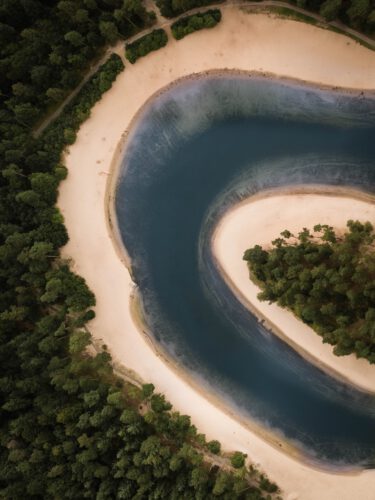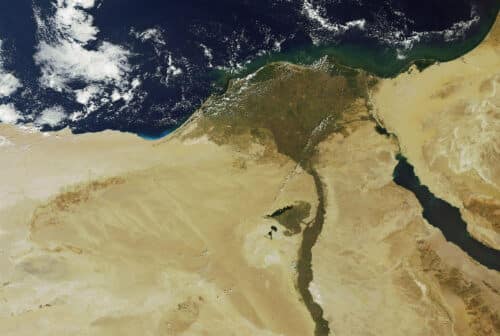Changes in the route of rivers will become more and more common in the coming years, following the rise in sea level caused by global climate change. This process may cause more flooding along the rivers, even in areas that did not suffer from them in the past
Racheli Vox, Angle - Science and Environment News Agency

A trip to a stream or a river is a perfect pastime for the weekends these days: it takes us out into the open spaces, where The chance of getting infected with corona is lower - and the flowing water (which is often accompanied by an abundance of shade) make these natural sites especially attractive in view of the heat that refuses to leave us.
When we travel in these places, it sometimes seems to us that they have not changed at all since we visited them on the annual XNUMXth grade trip, but streams and rivers actually change their course all the time - and in some cases, when such a change of course floods populated areas, it can have catastrophic results. In a new American study It was found that changes in the route of rivers will become more and more common in the coming years, following the rise in sea level caused by global climate change.
It is true that all the streams flow to the sea, but the route in which they do so is affected by many factors, including the slope of the ground, the movements of the tectonic plates that make up the earth's crust and the nature of the alluvium: materials such as sand, mud and stones that the water of the stream scrapes from the mountains and carries with it. When there is a change in one of these factors, the course of the river or stream may also change accordingly.
These route changes have advantages. "As ecologists of streams, we welcome such processes," says Avi Ozan, aquatic habitat ecologist at the Nature and Parks Authority. "Many streams have been straightened by man, so that they flow in a straight path, but such straightening destroys a large part of the natural character of the stream." according to him, The natural courses of streams are full of twists and turns. "The dynamic entanglements create structural complexity, and enable the development of more diverse ecosystems," he says.
However, when a river deviates from its regular course and floods areas in its vicinity, this may also cause a major disaster - especially when the area suddenly washed by water is inhabited. Such floods have caused some of the deadliest disasters in history, including the Yellow River flood, which occurred in China in 1887, and the Great China Flood, which occurred in several major rivers in the country in 1931. The number of dead in these two events together is estimated atAbout six million humans.
Between glaciers and rivers
In the new study, conducted by researchers from the California Institute of Technology (Caltech) and the University of California, and recently published in the leading scientific journal PNAS, the scientists focused on deltas: a triangle-like river formation that is formed when a lot of sediment sinks in the area where the river meets the sea and forces the river to split and flow around it in a number Branched arms. In such areas, such as the famous Nile Delta in Egypt and the Mississippi River Delta in the southern United States, the land is fertile and convenient for agriculture, and therefore people live in them Over half a billion Beni man in the world

The researchers found that the frequency of changes in the course of the rivers in the studied areas depends mainly on two factors: the sea level and the amount of drift in the river water. Therefore, when the global sea level rises - the frequency of track changes is also expected to increase.
Global sea level has risen more than 20 cm In the last 150 years - of which nine centimeters in the last 25 years alone. The main reason for this is The melting of the glaciers And the land ice in Antarctica, Greenland and the mountain tops around the world as part of the effects of climate change. To this must be added the level rise caused by the thermal expansion of the water due to the increase in the temperature of the oceans during this period.
According to the reports of the UN Panel of Climate Scientists (IPCC), the estimates are that the sea level is expected to rise by the end of this century by 74-30 centimeters (depending on the emissions scenario that will be realized). in other studies from recent years Even a sharper and faster increase is expected.
The effects of sea level rise can already be seen today in various island countries around the world, such as Micronesia in the Pacific Ocean, where the area of some of the islands has already shrunk significantly and some of them have even begun disappear completely from the map. The rise of the sea level caused many to lose their homes in Bangladesh, and began to cause flooding in the USA as well, for example in the city of Miami in Florida. According to the forecasts, the phenomenon will not pass over Israel either, and the level of the Mediterranean Sea on the coasts of the country is also expected to rise About a meter until the end of this century.
A blockage in the river
But how does the rise in sea level affect the course of the rivers? Rivers flow from a high place, like a mountain, to a low place - like a sea. Therefore, when the sea level rises, the lowest point in the path rises - and the flow gradient becomes more moderate. In such a situation, the water in the river flows more slowly, similar to how a ball rolls more slowly on a gentle slope than on a steep one.
This slowdown has an effect on what happens downstream, where some of the silt in the water sinks. "The investment of the silt depends in part on the speed of the flow: the slower it is, the more fine silt sinks," says Ozan. "When large amounts of silt sink - streams get blocked, and then the water has to break in other directions to keep flowing."
Some of the places that may be affected by such a process, such as the city of New Orleans in the USA, are already suffering from flooding events today. However, according to the study, it is possible that the deposition of alluvium will also occur in areas located upstream of the river, where it does not occur today, so that even places that are not used to dealing with floods will be under threat.
Prepare for changes
And what is the situation in Israel? It is true that our streams and rivers are different in nature from those examined in the study and there are almost no deltas in them, but even in them the flow route is far from constant. The Jordan River, for example, Changed his course a lot In recent decades following the drop in the level of the Dead Sea, which affects the border between the State of Israel and Jordan and the baptismal sites holy to Christianity.
According to Ozan, even the streams in Israel that were regulated so that they flow in a relatively straight line are changing their course. "A straight cut does not correspond with the natural processes, so the stream tries to return to equilibrium and starts rowing on the banks," he says. "These streams are a dynamic thing, and displacement is part of their character. Even Nahal Ayalon, which is surrounded by concrete, will move someday."
The researchers hope that their findings will help the authorities and residents to prepare for changes in the rivers' routes. "When these processes take place, they are huge and inevitable," Ozan concludes. "We need to prepare for them - and the climate crisis makes this need more important than ever."
More of the topic in Hayadan:
